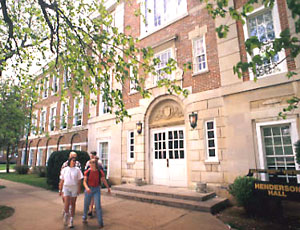
Tennessee Technological University
In 1915, following an intense lobbying effort on the part of Putnam County’s state representatives, the general assembly chartered Tennessee Polytechnic Institute (TPI), located on the grounds of Dixie College in Cookeville. Established in 1909 by the Church of Christ, Dixie College suffered from a lack of financial support and never achieved college status, serving instead as an academy of secondary education.
State Democratic politics made the creation of TPI a political football. The split in the Democratic Party over the question of prohibition had weakened the party and made party leaders anxious to guarantee an election victory. Governor Thomas C. Rye was given assurances that the location of a school in Cookeville would win support for him from Putnam and the surrounding counties, with the possible exception of White County. In another political move, the legislators created a technical school rather than a teachers college in order to still opposition from the three normal schools already in operation. Although high school administrators objected strenuously, TPI’s funding came from the high school fund rather than the normal school fund.
Soon after assuming control of the Dixie College campus, the legislature funded the construction of two dormitories for men and women. The old Dixie College building housed the campus classrooms, library, and administrative offices. In 1929 the general assembly passed a million-dollar bond issue to transform Tech into a college of technology equal to others in the southern states. Overcoming a threat of closure during the Great Depression, Tech received accreditation as a college-level institution from the Southern Association of Colleges and Schools in 1939. Although the name of the school and the emphasis on technology overshadowed other aspects of the curriculum, the charter of TPI charged it with the additional mission of training teachers for the Cumberland region. Women who attended Tech in the early years enrolled in the education courses.
Tech’s first presidents were Thomas Alva Early (1916-20), Quinton Smith (1920-38), and James M. Smith (1938-40). Everett Derryberry, who held a master’s degree in English earned as a Rhodes Scholar at Oxford University, was president from 1940 to 1974. Derryberry expanded the campus, raised the enrollment, and improved the curriculum. His achievements can be credited to his dynamic personality and political influence, as well as to his recruitment of able administrators and faculty. In addition, Derryberry’s tenure spanned a period of favorable economic, social, and political conditions in the state and nation.
The campus changed dramatically during the Derryberry years. Before 1940 the campus contained seven buildings. In 1949 the new library building opened. Between 1945 and 1965 a number of dormitories were constructed to accommodate the massive influx of students entering college after World War II. Between 1965 and 1971 the campus gained fifteen new buildings, all constructed in the Georgian and Classical Revival styles to maintain architectural unity.
In Derryberry’s last decade several important milestones were established. In 1964 Tech began racial integration without incident, the last of the state universities to comply with the Supreme Court ruling of 1954. In 1965 its name changed to Tennessee Technological University.
Derryberry’s retirement in 1974 opened a new chapter in Tech’s history. Professor of education Arliss Roaden, vice-provost of Ohio State University, became president. Roaden aspired to achieve national recognition for Tech by maintaining excellence in engineering while creating a multipurpose university. He emphasized quality in the student body and the faculty and gave increased attention and funding to the College of Business Administration. Roaden also launched a successful fund-raising campaign. During his tenure, a new fine arts building opened, and plans were made for a new library. Student enrollment passed 8,000 in 1980, and entering freshmen had the highest ACT scores of any Board of Regents school.
In the early 1980s Roaden persuaded Governor Lamar Alexander to propose research Centers of Excellence at the state’s universities. Tech was awarded four of the initial centers: Center for Manufacturing Research, Center for Water Resources, Center of Electrical Power, and Center for Educational Evaluation. The latter is no longer in operation.
In 1985 Roaden resigned to become executive director of the Tennessee Higher Education Commission. During Roaden’s administration, the issues of research and publication divided the faculty, with some taking the position that the president had “violated” their conditions of employment as teachers. To restore calm, Dr. Wallace Prescott, Derryberry’s chief academic officer, was called out of retirement to act as interim president after Roaden’s resignation. Prescott led the school until 1988, when Dr. Angelo Volpe accepted the position as president.
Volpe’s appearance symbolized a change in the character of Tech. He was the first Ph.D. (chemistry, University of Maryland) to be named as permanent president of Tech. He was also the first non-southerner and non-Protestant to be president. In many ways, Volpe reflected the spirit of Roaden’s philosophy. Tech had escaped, to some extent, its regional image; it was reaching out to broader horizons. The changing faculty and student body also reflected these new characteristics.
In 2000 Volpe retired and was replaced on July 1, 2000, by Dr. Robert R. Bell, the university’s former Dean of the College of Business Administration. Over 8,400 students were enrolled at the university during the fall 2000 semester.
Suggested Reading
Harvey G. Neufelt and W. Calvin Dickinson, “Dark and Mysterious Channels: The Creation of Tennessee Polytechnic Institute,” Tennessee Historical Quarterly 48 (1989): 144-50 and The Search for Identity: A History of Tennessee Technological University, 1915-1985 (1991)



